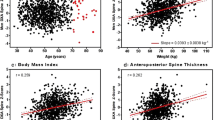Abstract
Summary
Two-dimensional areal bone mineral density (aBMD) of the proximal femur measured by three-dimensional quantitative computed tomography (QCT) in 91 elderly women was compared to dual-energy X-ray absorptiometry (DXA) aBMD results measured in the same patients. The measurements were highly correlated, though QCT aBMD values were marginally lower in absolute units. Transformation of the QCT aBMD values to T score values using National Health and Nutrition Examination Survey (NHANES) DXA-derived reference data improved agreement and clinical utility.
Introduction
World Health Organization guidelines promulgate aBMD (g cm−2) measurement of the proximal femur for the diagnosis of bone fragility. In recent years, there has been increasing interest in QCT to facilitate understanding of three-dimensional bone structure and strength.
Objective
To assist in comparison of QCT-derived data with DXA aBMD results, a technique for deriving aBMD from QCT measurements has been developed.
Methods
To test the validity of the QCT method, 91 elderly females were scanned on both DXA and CT scanners. QCT-derived DXA equivalent aBMD (QCTDXA aBMD) was calculated using CTXA Hip™ software (Mindways Software Inc., Austin, TX, USA) and compared to DXA-derived aBMD results.
Results
Test retest analysis indicated lower root mean square (RMS) errors for CTXA; F test between CTXA and DXA was significantly different at femoral neck (FN) and trochanter (TR) (p < 0.05). QCT underestimates DXA values by 0.02 ± 0.05 g cm−2 (total hip, TH), 0.01 ± 0.04 g cm−2 (FN), 0.03 ± 0.07 g cm−2 (inter-trochanter, IT), and 0.02 ± 0.05 g cm−2 (TR). The RMS errors (standard error of estimate) between QCT and DXA T scores for TH, FN, IT, and TR were 0.36, 0.40, 0.39, and 0.49, respectively.
Conclusions
This study shows that results from QCT aBMD appropriately adjusted can be evaluated against NHANES reference data to diagnose osteoporosis.



Similar content being viewed by others
References
Kanis JA, Gluer CC (2000) An update on the diagnosis and assessment of osteoporosis with densitometry. Committee of Scientific Advisors, International Osteoporosis Foundation. Osteoporosis Int 11:192–202
Tucker G, Metcalfe A, Pearce C et al (2007) The importance of calculating absolute rather than relative fracture risk. Bone 41(6):937–941
Lang TF, Keyak JH, Heitz MW et al (1997) Volumetric quantitative computed tomography of the proximal femur: precision and relation to bone strength. Bone 21:101–108
Mayhew PM, Thomas CD, Clement JG et al (2005) Relation between age, femoral neck cortical stability, and hip fracture risk. Lancet 366(9480):129–135
Prince RL, Devine A, Dhaliwal SS et al (2006) Effects of calcium supplementation on clinical fracture and bone structure: results of a 5-year, double-blind, placebo-controlled trial in elderly women. Arch Intern Med 166(8):869–875
Cann CE, Genant HK (1980) Precise measurement of vertebral mineral content using computed tomography. J Comput Assist Tomogr 4:493–500
Khoo BCC (2006) Dosimetry assessment for QCT (hip and spine) and 3-D DXA (hip) for Human Rights Ethics Committee (HREC) submission. Internal Report of Department of Medical Technology and Physics, Sir Charles Gairdner Hospital, Nedlands
Looker AC, Orwoll ES, Johnston CC Jr et al (1997) Prevalence of low femoral bone density in older US adults from NHANES III. J Bone Miner Res 12:1761–1768
Henzell S, Dhaliwal S, Pontifex R et al (2000) Precision error of fan-beam dual X-ray absorptiometry scans at the spine, hip, and forearm. J Clin Densitom 3(4):359–364
Genant HK, Grampp S, Gluer CC et al (1994) Universal standardization for dual X-ray absorptiometry: patient and phantom cross-calibration results. J Bone Miner Res 9:1503–1514
Hui SL, Gao S, Zhou XH et al (1997) Universal standardization of bone density measurements: a method with optimal properties for calibration among several instruments. J Bone Miner Res 12:1463–1470
Sheperd JA, Fan B, Lu Y et al (2006) Comparison of BMD for prodigy and Delphi spine and femur scans. Osteoporosis Int 17:1303–1308
Goodsitt MM (1992) Conversion relations for quantitative CT bone mineral densities measured with solid and liquid calibration standards. Bone and Mineral 19:145–158
Nurzenski MK, Briffa NK, Price RI et al (2007) Geometric indices of bone strength are associated with physical activity and dietary calcium intake in healthy older women. J Bone Miner Res. 22(3):416–424
Conflicts of interest
Dr. Brown and Dr. Cann are both stockholders of Mindways Software Inc.
Author information
Authors and Affiliations
Corresponding author
Appendix
Appendix
The TH QCT-derived aBMD may be converted to an equivalent TH DXA T score using the following relationships to facilitate application with WHO guidelines:
or
Where \({\text{QCT}}_{{\text{DXA\_TH\_}}T_{{\text{scores}}} } \) is the NHANES III QCTDXA T score for the TH; \({\text{QCT}}_{{\text{TH\_aBMD}}} \) is the QCT-derived aBMD for the TH and \({\text{DXA}}_{{\text{TH\_}}T_{{\text{scores}}} } \) is the equivalent DXA T score for the TH that may be applied to WHO T scores (for TH).
Similar relationships may also be derived for the FN:
or
inter-trochanter (IT):
or
and trochanter (TR):
or
Rights and permissions
About this article
Cite this article
Khoo, B.C.C., Brown, K., Cann, C. et al. Comparison of QCT-derived and DXA-derived areal bone mineral density and T scores. Osteoporos Int 20, 1539–1545 (2009). https://doi.org/10.1007/s00198-008-0820-y
Received:
Accepted:
Published:
Issue Date:
DOI: https://doi.org/10.1007/s00198-008-0820-y




